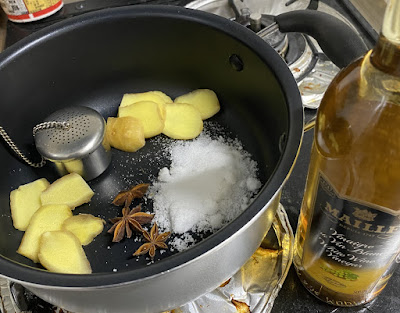1 Tbs sugar
fresh ginger (a piece about the size of a thumb)
fresh garlic (however little or much you like)
coriander seeds or roots (seeds - about 1 full tsp, roots - if you have them, a small bundle will do)
pepper grains (about 1tsp)
1-2 cardamom seeds
star anise (2-3 full stars)
lemon grass (frozen or dried) (a good bunch of dried lemon grass or 1-2 stalks of frozen)
How to:
Meat:
Before you make the soup, you should season your meat. I usually season mine with salt/pepper/garlic lightly. Then add sliced onion and sandwich it between layers of meat. If you're good at cutting/slicing onions, do it yourself. If you're not (like me), you can see if your supermarket has readily sliced onion.
Here in Japan, most supermarkets have a 'tamanegi salad' (玉ねぎサラダ lit. onion salad), which consists of shredded lettuce and sliced onions. I just pick out the lettuce before adding the onions to the meat (you don't have to if you're fine with cooked lettuce).
Personal preference: for beef I prefer regular or red onions (玉ねぎ)while for chicken I like having it with green onions or leeks (長ネギ)but really, either is fine and again, up to your preference.
Broth:
You can start with the water if you don't want to use a kettle or don't have one. I boiled water in my kettle while I prepared the other ingredients but you can also start with water and then add the ingredients. The order doesn't really matter. The salt and sugar just dissolve faster in warm water, so there isn't really any reason other reason for having warm water for the recipe.
I used a tea-egg/tea infuser (we call them Tee Ei in German, which means tea egg) for some of the floaty-er ingredients such as the pepper, coriander seeds/roots and lemon grass (since I used dried lemon grass). I would have put the anise in with those but there was no more space lol. If you use frozen lemon grass stalks you can just let them float because they're easy to fish out/avoid when you're cooking the meat later.
If you do not have a tea-egg/tea infuser you can also use disposable teabags, which are available online or sometimes in tea stores that sell loose-leaf tea. I try to be an eco-friendly person, so I use my tea infuser (also available online).
Put the rest of the dry ingredients into the pot and stir gently until salt and sugar have dissolved. Then add the vinegar last. Stir again and you're done.
Now you can bring the mixture to a boil and then put in your meat.
Depending on how thick your slices are, you need to cook it for a longer or shorter period. You can do it shabu shabu style - dipping the meat in with chopsticks, or you can do it with a perforated ladle/spoon (穴あきレンゲ) to put in and fish out the meat.
The meat is usually fished out and then wrapped into rice paper, along with salad and herbs as well as rice noodles/rice vermicelli called bún to make 'summer rolls' (aka not fried spring rolls = 生春巻き).
For this style of hot pot, the soup is eaten at the end - or a day later. I prefer to eat it a day later. The broth will have gotten more flavourful thanks to all the meat and onions you put in and thanks to cooking it for an extended period of time (resulting in a reduced, more condensed soup stock). I eat it with all the leftovers (some meat, some lettuce, rice noodles - add some cut green onions and coriander on top, voila).



Comments
Post a Comment